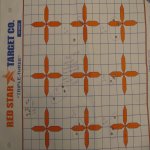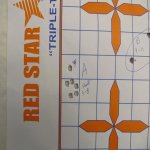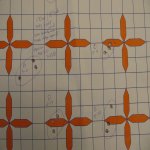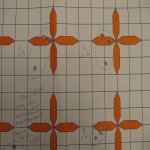Mystic Precision
CGN Ultra frequent flyer
- Location
- Summerland, BC
I get asked often about how I load tune. I have a few very old posts on Longrangehunter.com but just playing with a customer rifle so thought I would give the short version.
Thing to know: Customer supplied scope has a very thick hunting duplex reticle. It actually covers the orange cross so there is possible aiming error in all groups. 1/16 to 1/8" would not surprise me. I am dialing in the zero between A, B and C
Rifle spec, Rem 783 with a brand new action, IBI 6mm Creedmoor, 8 twist, heavy barrel, M11 style muzzle brake, XRS stock - so far not bedded as there are some adjustments we may be making to the rifle set up, Timney trigger, Customer supplied scope in Burris Sig ZEE rings.
Running new Starline brass.. just resized the neck to get rid of any wonkles, deburred. Fed 210primers, H4350, Berger 109gr Hybrid.. new bullet this season and have wanted to test it. Set the ogive 10 thou off the lands.
Distance 170m/187yds... very light conditions, overcast and cool. Way too many hunters where I shoot further and I didn't want to bug them by blasting away so came back to my rimfire area just to get a starting point.
Rifle was bore sighted, first 2rds on a new clean bore into the dirt to ensure I was in the right general area.
Each letter is a new charge level 0.3gr apart. The numbers beside is the actual number of rds down the bore.... I think you can guess on my feeling about 'barrel break in'.


Load A is just a starting point I extrapolated from the Hodgdon load data range. Except for 1 high shot, the other 5rds did very nicely... lucky guess. If the customer wanted a low pressure load, this would certainly do it.... I would play 0.1gr either side and see what happened.
Load B shows signs of the next node. 2 +1 out, good signs that you are working into the node

Load C first 2 almost touch, 3rd just out. Pattern similar to B just alot tighter. could be load? Could be aiming error? new case? Maybe a gust? No matter, this is where I need to spend more time. The goal is stable low vertical groups.
Load D as you get to the far side of ideal, the group size doesn't change BUT it plots vertical. regardless of what the chrony says, if you see this type of vertical pattern, you are going have issues the further you go. What you will see on target is ping pong... one shot goes high or low, then on, then either high or low, you are bouncing above and below the target with the occasional hit. Your view through the scope is ping pong as you dance up and down hoping to guess where the next shot goes. On the plus side, your windage will be super tight... but you just can't hit anything consistently.
I like how wide this node is so far... early days but looking very promising
Load E the vertical is now really obvious as you fall off the node. Group size also grows.

Load F this is now on the far side of of the node and no longer useable. It has the same 2+1 look that it had going into the node. For those that have a group with 2 clusters, as long as the scope and rifle isnt broken, likely it is a tuning issue.
Load G is just a wide loose group. We are now heading into the charge area you see with shooters looking for 'big speed'. If I were to increase charge, it would go back into tune but it would be a very thin node - small powder changes have massive affect on the grouping. pressure signs would start to show, and the load may be fussy. Too old to fuss with this nonsense anymore... and it is hard on bores and brass anyways.
So the barrel has now seen 26rds, I know my node range and have a load to fine tune. When you are using known accurate bullets, components, in a well developed chamber, that barrel better shoot within load ranges that have already been shown to work well. Chambers like the creedmoor, 308, BR are ubber popular because they need little fussing to make work. If your rifle and optics is working well and you are fighting to get a consistent load, think new barrel.
I might clean the bore next time out... I doubt there will be anything to report. Well made, properly lapped barrels work right out of the box.
My next test will likely be at 700m... going to take Load C as well as C+0,1 and 0.2gr. Will be VERY obvious which works best.
After all the brass is fireformed and we settle on the final set up, the customer can play around with seating depths and whatever components floats his boat. First impressions, very happy with the Berger 109gr Hybrids.. they behave very well in set up and so far, load tune seems to be quite wide. A few hundred rds will confirm how stable everything is but this rig is ready to smash some steel.
Jerry
Thing to know: Customer supplied scope has a very thick hunting duplex reticle. It actually covers the orange cross so there is possible aiming error in all groups. 1/16 to 1/8" would not surprise me. I am dialing in the zero between A, B and C
Rifle spec, Rem 783 with a brand new action, IBI 6mm Creedmoor, 8 twist, heavy barrel, M11 style muzzle brake, XRS stock - so far not bedded as there are some adjustments we may be making to the rifle set up, Timney trigger, Customer supplied scope in Burris Sig ZEE rings.
Running new Starline brass.. just resized the neck to get rid of any wonkles, deburred. Fed 210primers, H4350, Berger 109gr Hybrid.. new bullet this season and have wanted to test it. Set the ogive 10 thou off the lands.
Distance 170m/187yds... very light conditions, overcast and cool. Way too many hunters where I shoot further and I didn't want to bug them by blasting away so came back to my rimfire area just to get a starting point.
Rifle was bore sighted, first 2rds on a new clean bore into the dirt to ensure I was in the right general area.
Each letter is a new charge level 0.3gr apart. The numbers beside is the actual number of rds down the bore.... I think you can guess on my feeling about 'barrel break in'.


Load A is just a starting point I extrapolated from the Hodgdon load data range. Except for 1 high shot, the other 5rds did very nicely... lucky guess. If the customer wanted a low pressure load, this would certainly do it.... I would play 0.1gr either side and see what happened.
Load B shows signs of the next node. 2 +1 out, good signs that you are working into the node

Load C first 2 almost touch, 3rd just out. Pattern similar to B just alot tighter. could be load? Could be aiming error? new case? Maybe a gust? No matter, this is where I need to spend more time. The goal is stable low vertical groups.
Load D as you get to the far side of ideal, the group size doesn't change BUT it plots vertical. regardless of what the chrony says, if you see this type of vertical pattern, you are going have issues the further you go. What you will see on target is ping pong... one shot goes high or low, then on, then either high or low, you are bouncing above and below the target with the occasional hit. Your view through the scope is ping pong as you dance up and down hoping to guess where the next shot goes. On the plus side, your windage will be super tight... but you just can't hit anything consistently.
I like how wide this node is so far... early days but looking very promising
Load E the vertical is now really obvious as you fall off the node. Group size also grows.

Load F this is now on the far side of of the node and no longer useable. It has the same 2+1 look that it had going into the node. For those that have a group with 2 clusters, as long as the scope and rifle isnt broken, likely it is a tuning issue.
Load G is just a wide loose group. We are now heading into the charge area you see with shooters looking for 'big speed'. If I were to increase charge, it would go back into tune but it would be a very thin node - small powder changes have massive affect on the grouping. pressure signs would start to show, and the load may be fussy. Too old to fuss with this nonsense anymore... and it is hard on bores and brass anyways.
So the barrel has now seen 26rds, I know my node range and have a load to fine tune. When you are using known accurate bullets, components, in a well developed chamber, that barrel better shoot within load ranges that have already been shown to work well. Chambers like the creedmoor, 308, BR are ubber popular because they need little fussing to make work. If your rifle and optics is working well and you are fighting to get a consistent load, think new barrel.
I might clean the bore next time out... I doubt there will be anything to report. Well made, properly lapped barrels work right out of the box.
My next test will likely be at 700m... going to take Load C as well as C+0,1 and 0.2gr. Will be VERY obvious which works best.
After all the brass is fireformed and we settle on the final set up, the customer can play around with seating depths and whatever components floats his boat. First impressions, very happy with the Berger 109gr Hybrids.. they behave very well in set up and so far, load tune seems to be quite wide. A few hundred rds will confirm how stable everything is but this rig is ready to smash some steel.
Jerry
Attachments
Last edited:











































































